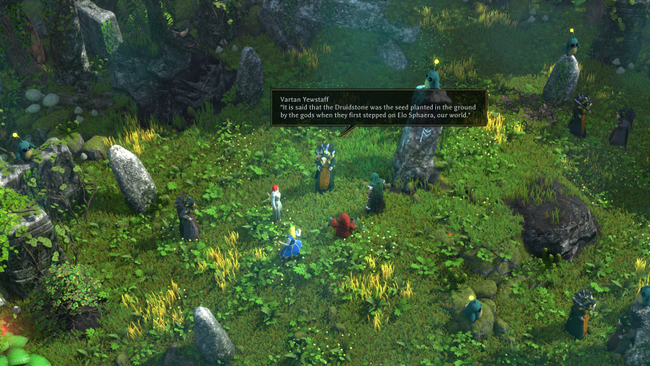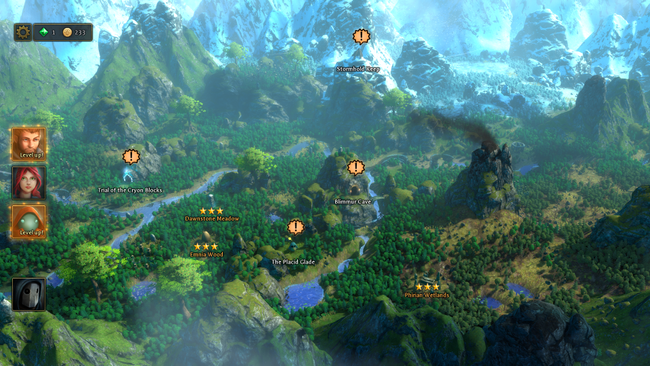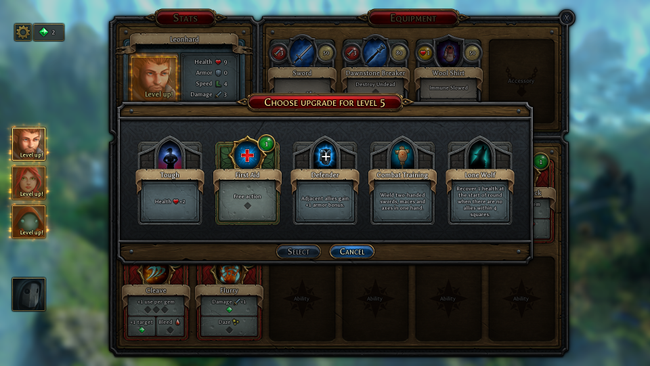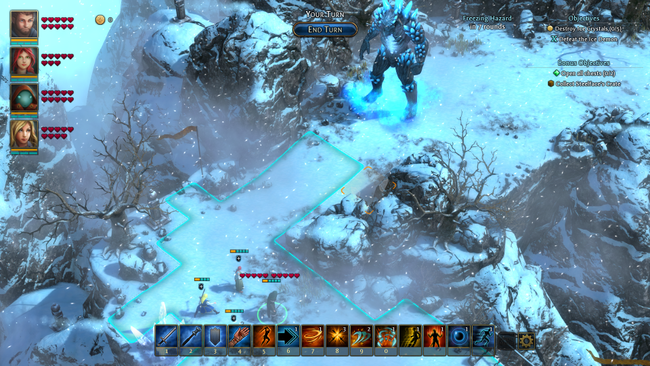Druidstone: The Secret of the Menhir Forest Review
When some Almost Human alumni announced the formation of Ctrl Alt Ninja and their debut release Druidstone: The Secret of Menhir Forest, I originally wasn't really aware of the project. I hadn't really had any experience with the Legend of Grimrock series, so this new studio title wasn't originally on my radar. However, under a new name came a slight shift in genre, and Druidstone ended up as a tactical style RPG in the vein of Divinity: Original Sin instead of something more similar to the Grimrock games. I eventually found that Druidstone manages to put its own spin on some of the ideas of contemporary grid-based CRPGs, and makes a pretty good entry-point for the subgenre overall.

Druidstone tells a simple story of a vast forest under the threat of a force of nature known as the Cancer. Immediately at the outset, we're introduced to our primary trio of characters: the amnesiac forest warden Leonhard, Aava -- the daughter of the powerful archdruid, and the whimsical Red Priest Oiko. While the narrative isn't at the forefront of Druidstone, the quick and snappy dialogue between characters is genuinely fun to read and cutscenes are rarely overwrought with too much exposition or melodrama.
This trio of heroes (eventually joined by a fourth) then set out on a journey seeking a solution to the Cancer threat, find the Druidstone, and rescue Aava's missing father. The story unfolds across several individual chapters, each of which containing various combat conditions, enemy types, and bonus objectives. The available missions are also slightly non-linear in terms of order, often you'll have two or three options to pick from until they eventually converge as final series of battles approaches.
There's a common narrative throughline for the story present in these missions, but it takes the form of supplemental character studies more than a singular plot thrust. Its' more like an American cartoon rather than a serialized manga comic, as an analogy.

Combat in Druidstone plays out in team turns where each unit is given a movement pool and an action point. Interestingly, all characters on the player team can execute their movement and actions in any order. For instance, Leonhard can attack with an action ability, followed by Aava moving, then Leonhard finishing his turn with some movement, and finally having Aava act. This provides a lot of flexibility compared to similar games that divide turns purely by character, or games that don't allow movement to be split throughout your team's turn.
Some abilities are "Free Actions", which are abilities that can be performed at any time without costing from a characters Action Point pool. Often these are supplemental skills like dashing an extra distance or charging up the power of a spell. Both free actions and normal abilities are only able to be used so many times in a battle, which leads to a certain amount of consideration required behind deciding whether to use these abilities early on to establish momentum, or saving for later in a fight to use in a pinch. Acquiring ad-hoc abilities from Spellbooks or Chest objects located around the battlefields are additional ways to increase the number of actions a given unit can take on their turns.
One of Druidstone's strengths is the variety of mission types across its limited number of battles. Some quests will require you to simply defeat a specific enemy, but others will require you to escort an NPC to a given location, or destroy specific objects dotted in the corners of the map. On top of this are a slate of bonus objectives that give extra rewards. These are more likely to be fixed across missions, such as finishing while keeping all units alive or opening every chest, but these will occasionally dip into bespoke goals that are unique to a given mission. While there are a limited number of locations -- only about 30 in total -- the vast majority of them feel smartly crafted and can be replayed for some extra experience, or another try at missing bonus objectives.

One mechanical commonality between all of Druidstone's battles is that each will slowly introduce a steady wave of enemy reinforcements from random locations once a handful of turns has passed. While there are cases where this design can initially seem frustrating, it also helps to incentivize taking risks and applying strategic forethought. Turtling and waiting for enemies to approach a well-defended formation is often a way to break difficult encounter designs in the easiest possible manner in similar games, and it did feel frustrating at first to feel pressured to play each battle more quickly that I normally would have.
Eventually, I did end up acclimating to the quicker pace dictated by the threat of constant reinforcement and I feel that Druidstone does a lot to ensure that the reinforcements are never too much of a burden. The location of new enemy reinforcements is almost always marked on the map the turn before they show up, and on top of that, they don't act on their first turn. So there's enough time and warning given to not upturn a fight immediately with an unpredictable enemy spawn, but the general threat is still enough to require changing up strategies on the fly just a bit.

Gear and abilities are also slightly different in Druidstone compared to many comtemporaries. Early on you'll unlock the game's singular shop, whose inventory expands as you progress. New gear never invalidates old equipment though -- weapons available for purchase late in the game will simply have different abilities than earlier ones. For instance, one of Leonhard's early weapons can be upgraded to pierce through armor while later ones can instead steal health or give a free use of an ability like Whirlwind, but doesn't do a higher amount of damage on its own. This same mentality also goes for deciding what armor, accessories, and abilities to slot for any given situation.
Upgrading gear or abilities requires the use of gemstones. Gemstones earned from completing missions and bonus objectives can be used to increase the potency of equipment or the number of times an ability can be used. These are free to slot and unslot as one pleases, so it gives an extra dimension of flexibility when it comes to decided how to kit out any given unit. The acquisition of gemstones from completing missions, new abilities from leveling up, and more gear from expanding the shop inventory all offer a nice sense of progression despite the lack of explicit gear improvement in terms of base stats.
It is in this way that Druidstone's slight puzzle-like nature is apparent, and it meshes well with the unique objectives present in each map. Certain loadouts emphasizing movement might be suited for specific battles, while others may require simply being able to deal as much damage in as few turns as possible. In one case, I had to reconfigure my abilities in order to slot more healing and protection in order to keep NPCs alive in a later chapter of the game.

Druidstone is a brief experience, and I was able to complete the game in normal mode with all bonus objectives in under 20 hours. Those seeking to complete all achievements and finish the game on Hard will be able to squeeze a little more time out of it, but once every mission is conquered there's not a lot of incentive to replay old battles for diminishing returns on experience or to acquire enough gold to purchase equipment that was previously skipped. In a way, it was refreshing to have a game of this style allow itself to be enjoyed in just a few gameplay sessions, but the omission of any sort of longer-term replay factor still feels like a missed opportunity. Mod tools have been advertised by the developers, so maybe revisiting Druidstone in the future will have user-created stories to bolster the light framework available at release.
Druidstone is a perfect entry point for RPG fans that are interested in this style of tactical game without having to invest several dozens of hours in a longer experience that they may not enjoy. It doesn't offer a lot in terms of unique themes or robust storytelling, but it's balanced out by an impressive variety of encounter designs and flexibility for different playstyles. On top of these strengths, it also offers some surprisingly good musical scores and environmental art. It's a strong overall package that, while brief, was a joy to play through.